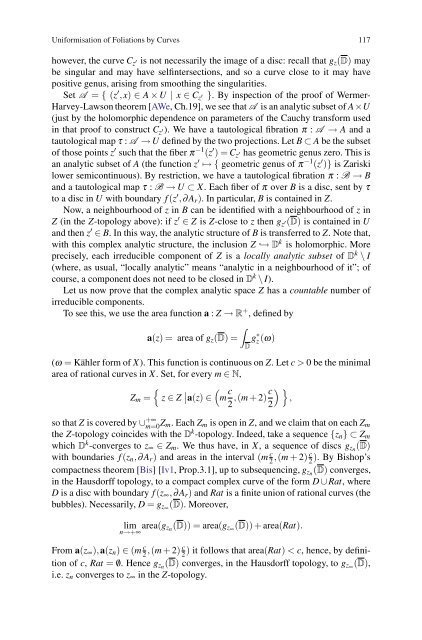Discrete Holomorphic Local Dynamical Systems
Discrete Holomorphic Local Dynamical Systems
Discrete Holomorphic Local Dynamical Systems
Create successful ePaper yourself
Turn your PDF publications into a flip-book with our unique Google optimized e-Paper software.
Uniformisation of Foliations by Curves 117<br />
however, the curve Cz ′ is not necessarily the image of a disc: recall that gz(D) may<br />
be singular and may have selfintersections, and so a curve close to it may have<br />
positive genus, arising from smoothing the singularities.<br />
Set A = { (z ′ ,x) ∈ A × U | x ∈ Cz ′ }. By inspection of the proof of Wermer-<br />
Harvey-Lawson theorem [AWe, Ch.19], we see that A is an analytic subset of A×U<br />
(just by the holomorphic dependence on parameters of the Cauchy transform used<br />
in that proof to construct Cz ′). We have a tautological fibration π : A → A and a<br />
tautological map τ : A → U defined by the two projections. Let B ⊂ A be the subset<br />
of those points z ′ such that the fiber π−1 (z ′ )=Cz ′ has geometric genus zero. This is<br />
an analytic subset of A (the function z ′ ↦→{geometric genus of π−1 (z ′ )} is Zariski<br />
lower semicontinuous). By restriction, we have a tautological fibration π : B → B<br />
and a tautological map τ : B → U ⊂ X. Each fiber of π over B is a disc, sent by τ<br />
to a disc in U with boundary f (z ′ ,∂Ar). In particular, B is contained in Z.<br />
Now, a neighbourhood of z in B can be identified with a neighbourhood of z in<br />
Z (in the Z-topology above): if z ′ ∈ Z is Z-close to z then gz ′(D) is contained in U<br />
and then z ′ ∈ B. In this way, the analytic structure of B is transferred to Z. Note that,<br />
with this complex analytic structure, the inclusion Z ↩→ Dk is holomorphic. More<br />
precisely, each irreducible component of Z is a locally analytic subset of Dk \ I<br />
(where, as usual, “locally analytic” means “analytic in a neighbourhood of it”; of<br />
course, a component does not need to be closed in Dk \ I).<br />
Let us now prove that the complex analytic space Z has a countable number of<br />
irreducible components.<br />
To see this, we use the area function a : Z → R + ,definedby<br />
�<br />
a(z)= area of gz(D)= g<br />
D<br />
∗ z (ω)<br />
(ω = Kähler form of X). This function is continuous on Z.Letc > 0 be the minimal<br />
area of rational curves in X.Set,foreverym∈N, �<br />
Zm = z ∈ Z � �<br />
�a(z) ∈ m c c<br />
��<br />
,(m + 2) ,<br />
2 2<br />
so that Z is covered by ∪ +∞<br />
m=0Zm. Each Zm is open in Z, and we claim that on each Zm<br />
the Z-topology coincides with the Dk-topology. Indeed, take a sequence {zn}⊂Zm<br />
which Dk-converges to z∞ ∈ Zm. We thus have, in X, a sequence of discs gzn (D)<br />
with boundaries f (zn,∂Ar) and areas in the interval (m c 2 ,(m + 2) c 2 ). By Bishop’s<br />
compactness theorem [Bis][Iv1, Prop.3.1], up to subsequencing, gzn (D) converges,<br />
in the Hausdorff topology, to a compact complex curve of the form D ∪ Rat, where<br />
D is a disc with boundary f (z∞,∂Ar) and Rat is a finite union of rational curves (the<br />
bubbles). Necessarily, D = gz∞ (D). Moreover,<br />
lim area(gzn (D)) = area(gz∞ (D)) + area(Rat).<br />
n→+∞<br />
From a(z∞),a(zn) ∈ (m c 2 ,(m + 2) c 2 ) it follows that area(Rat) < c, hence, by definition<br />
of c, Rat = /0. Hence gzn (D) converges, in the Hausdorff topology, to gz∞ (D),<br />
i.e. zn converges to z∞ in the Z-topology.



